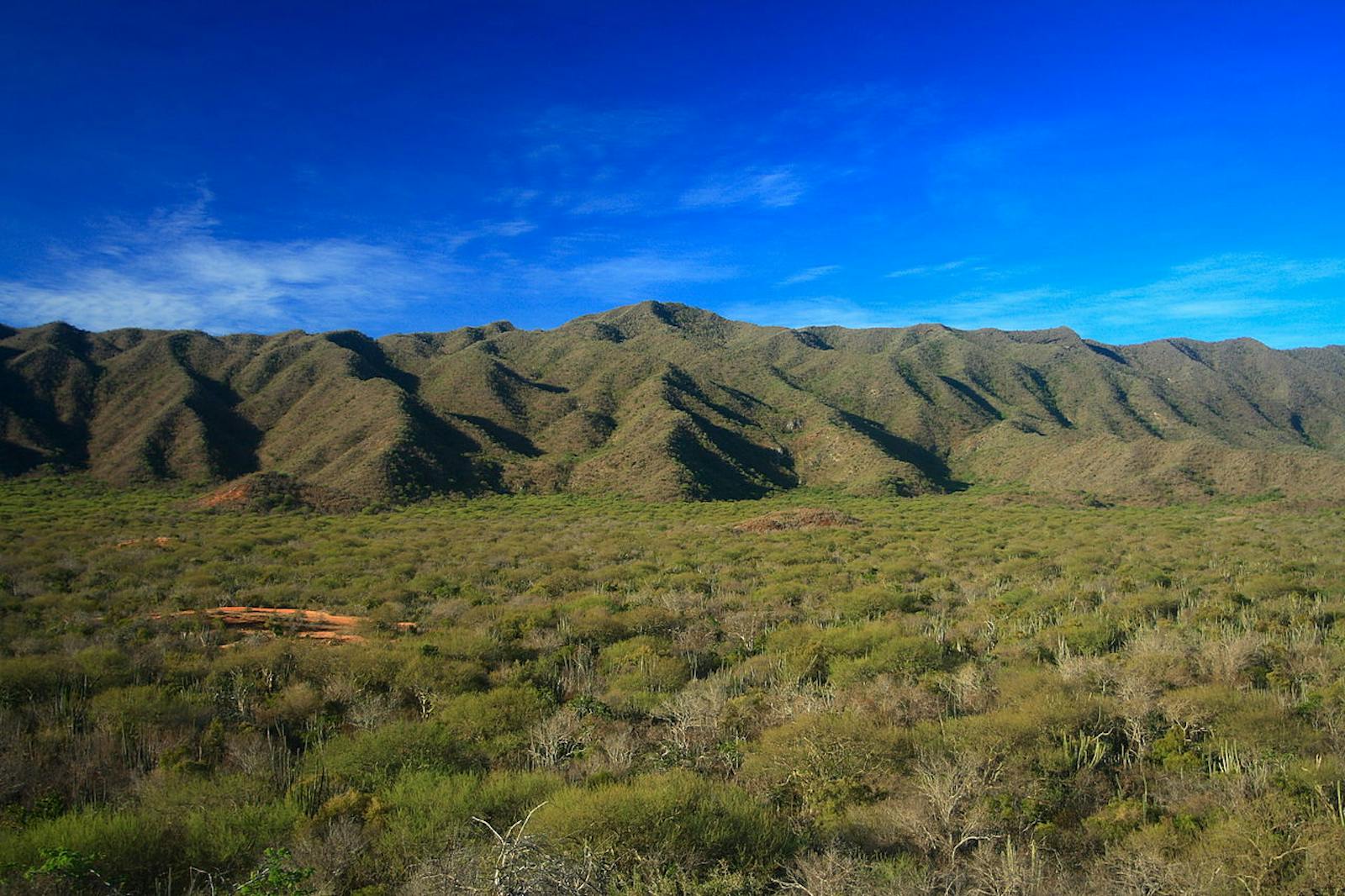Araya and Paria Xeric Scrub
The ecoregion’s land area is provided in units of 1,000 hectares. The protection goal is the Global Safety Net (GSN1) area for the given ecoregion. The protection level indicates the percentage of the GSN goal that is currently protected on a scale of 0-10.
Bioregion: Venezuelan Coast (NT23)
Realm: Southern America
Ecoregion Size (1000 ha):
529
Ecoregion ID:
597
Conservation Target:
7%
Protection Level:
7
States: Venezuela
Flocks of parrot were once numerous in these dry scrub forests of Venezuela. The Araya and Paria Xeric Scrub ecoregion is characterized not only as being very dry environments, but also one of the last refuges to several rare and restricted range animal species such as the vulnerable yellow-shouldered Amazon parrot, which is threatened by habitat degradation and the illegal pet trade. Remaining habitat for these and many other species is now severely fragmented by human settlements and the agricultural frontier; protecting remnant habitats is critically important for their conservation to prevent their extinction.
The ecoregion extends through portions of Margarita Island, the Araya-Paria peninsula, and onto the mainland of Cumaná in Venezuela. It encompasses a diverse geography, including mountain ranges, hills, sandy beaches, dunes, and salt marshes. The climatic conditions along this ecoregion vary substantially. Average temperatures range between 26–27°C, but can be higher in Araya and the dry lands of Margarita and lower in Cerro Copey and the surrounding moist valleys and mountains.
Vegetation of the coastal ranges of Margarita and Araya-Paria peninsula is characterized by herbs adapted to sandy soils and high salinity, and thorn scrubs adapted to dry conditions. The low height forests of deciduous trees in the mainland and Paria peninsula are moderately dense with a relatively well-developed understory.
Plants of the Cerro Copey and adjacent mountains are very similar to those of the Cordillera de la Costa Montane Forest, with relatively dense semi-deciduous low- to mid-height forests at lower elevations, submontane evergreen forests at mid-elevations with many epiphytes and palms, and montane evergreen shrub at higher elevations. Some plant species that are found exclusively in the Cerro Copey range of this ecoregion include Argythamnia erubescens, Blakea monticola, Clerodendrum margaritense, Croton margaritensis, Inga macrantha, and Mikania johnstonii.
.jpg)
The flagship species of the Araya and Paria Xeric Scrub ecoregion is the yellow-shouldered amazon. Image credit: Creative Commons
Despite its low degree of endemism and low species diversity, this ecoregion is of high conservation concern due to its status as a refuge for several restricted range species. It includes key habitat for vulnerable bird species in the Neotropics, such as the yellow-shouldered amazon, which is seriously threatened by the pet trade and habitat destruction.
A Margaritan subspecies of the blue-crowned parakeet also occurs in the arid zones surrounding the mangroves of La Restinga Lagoon and is also severely threatened by the pet trade. The Chacopata Lagoon has the largest pelican colony in Venezuela, and is used by large groups of flamingos.
This ecoregion occupies areas where loggerhead and green turtles reproduce as well. In Venezuela, the leatherback turtle has its principal nesting zone along the northern coast of Paria peninsula. The Cerro Copey constitutes a humid enclave, where many historically introduced species can be found, including the Margaritan cotton-tail rabbit and the Margarita capuchin monkey.
To protect the many restricted range species that occupy this ecoregion, several protected areas have been created around the most notable ecosystems, protecting mangroves and arid areas. These include the Kronstadt Island Wildlife Sanctuary, Mochima National Park, Cerro El Copey National Park, Cerro Matasiete and the Guayamurí Natural Monument, Laguna de la Restinga National Park, Laguna de Las Marites Natural Monument, and Las Tetas de María Guevara Monument. Nevertheless, sufficient protection of these areas is not covered by the governmental institution of National Parks (INPARQUES), and the major area of the Macanao peninsula remains unprotected.
The Araya and Paria Xeric Scrub ecoregion faces a suite of threats: overgrazing of goats in Araya and Macanao, deforestation for sand exploitation in the lowland areas of Macanao, tourism—including treks in rustic vehicles across restricted areas of La Restinga National Park—pollution, exotic species introduction, and urbanization in lagoons around Cumaná.
The priority conservation actions for the next decade are to: 1) increase the number of and connectivity between protected areas in the Araya and Macanao peninsulas; 2) restrict salt and sand exploitation; and 3) reduce overgrazing practices.
Citations
1. Bonaccorso, E. 2018. Northern South America: Northern Venezuela. https://www.worldwildlife.org /ecoregions/nt1301. Accessed June 8, 2018.
2. Huber, O., and C. Alarcon. 1988. Mapa de vegetación de Venezuela. 1:2,000,000. Ministerio del Ambiente y de los Recursos Naturales Renovables, Caracas, Venezuela.
3. Lentino, M. and A.R. Bruni. 1994. Humedales Costeros de Venezuela: Situación Ambiental. Sociedad Conservacionista Audubon de Venezuela, Caracas.
4. BirdLife International. 2017. Amazona barbadensis (amended version of 2016 assessment). The IUCN Red List of Threatened Species 2017: e.T22686325A110628721. http://dx.doi.org/10.2305/IUCN.UK.2017-1.RLTS.T22686325A110628721.en. Downloaded on 30 August 2018.




